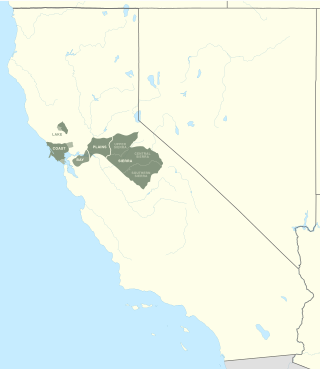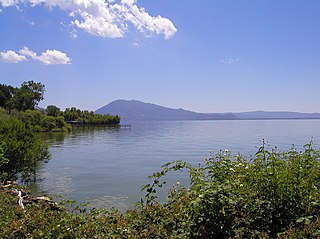The Bay Miwok are a cultural and linguistic group of Miwok, a Native American people in Northern California who live in Contra Costa County. They joined the Franciscan mission system during the early nineteenth century, suffered a devastating population decline, and lost their language as they intermarried with other native California ethnic groups and learned the Spanish language.

The Miwok or Miwokan languages, also known as Moquelumnan or Miwuk, are a group of endangered languages spoken in central California by the Miwok peoples, ranging from the Bay Area to the Sierra Nevada. There are seven Miwok languages, four of which have distinct regional dialects. There are a few dozen speakers of the three Sierra Miwok languages, and in 1994 there were two speakers of Lake Miwok. The best attested language is Southern Sierra Miwok, from which the name Yosemite originates. The name Miwok comes from the Northern Sierra Miwok word miw·yk meaning 'people.'

The Lake Miwok are a branch of the Miwok, a Native American people of Northern California. The Lake Miwok lived in the Clear Lake basin of what is now called Lake County. While they did not have an overarching name for themselves, the Lake Miwok word for people, Hotsa-ho, was suggested by A. L. Kroeber as a possible endonym, keeping with a common practice among tribal groups and the ethnographers studying them in the early 20th Century and with the term Miwok itself, which is the Central Sierra Miwok word for people.

The mythology of the Miwok Native Americans are myths of their world order, their creation stories and 'how things came to be' created. Miwok myths suggest their spiritual and philosophical world view. In several different creation stories collected from Miwok people, Coyote was seen as their ancestor and creator god, sometimes with the help of other animals, forming the earth and making people out of humble materials like feathers or twigs.
Achomawi traditional narratives include myths, legends, tales, and oral histories preserved by the Achomawi people of the Pit River basin of Northeastern California.
Coast Miwok traditional narratives include myths, legends, tales, and oral histories preserved by the Coast Miwok people of the central California coast immediately north of San Francisco Bay.
Plains Miwok and Sierra Miwok traditional narratives include myths, legends, tales, and oral histories preserved by the Miwok people of the central California, specifically those of Sacramento Valley and Sierra Mountains. These Miwoks are the linguistically related speakers of the Plains and Sierra Miwok languages and their descendants. At the time of European entry, local groups that spoke these languages participated in the general cultural pattern of central California.
Eel River Athapaskan traditional narratives include myths, legends, tales, and oral histories.
Hupa traditional narratives include myths, legends, tales, and oral histories preserved by the Hupa, Chilula, and Whilkut people of the Trinity River basin and vicinity of northwestern California. The Hupa people of modern times number in the several thousands and live in the Hoopa Valley located in Humboldt County, California.
Karuk traditional narratives include myths, legends, tales, and oral histories preserved by the Karuk (Karok) people of the Klamath River basin of northwestern California.
Kato traditional narratives include myths, legends, tales, and oral histories preserved by the Kato (Cahto) people of the Eel River basin of northwestern California.
Maidu traditional narratives include myths, legends, tales, and oral histories preserved by the Maidu, Konkow, and Nisenan people of eastern Sacramento Valley and foothills in northeastern California.
Modoc traditional narratives include myths, legends, tales, and oral histories preserved by the Modoc and Klamath people of northern California and southern Oregon.
Mono traditional narratives include myths, legends, tales, and oral histories preserved by the Mono people, including the Owens Valley Paiute east of the Sierra Nevada and the Monache on that range's western slope, in present-day eastern California.
Salinan traditional narratives include myths, legends, tales, and oral histories preserved by the Salinan people of the central California coast.
Serrano traditional narratives include myths, legends, tales, and oral histories preserved by the Serrano people of the San Bernardino Mountains and southern Mojave Desert of southern California, originally in the Serrano language.
Shasta traditional narratives include myths, legends, tales, and oral histories preserved by the Shasta people of northern California and southern Oregon.
Wiyot traditional narratives include myths, legends, tales, and oral histories preserved by the Wiyot people of the Humboldt Bay area of northwestern California.
Yana traditional narratives include myths, legends, tales, and oral histories preserved by the Yana people of the eastern Sacramento Valley and foothills of northeastern California.
The Lake Miwok language is an extinct language of Northern California, traditionally spoken in an area adjacent to the Clear Lake. It is one of the languages of the Clear Lake Linguistic Area, along with Patwin, East and Southeastern Pomo, and Wappo.